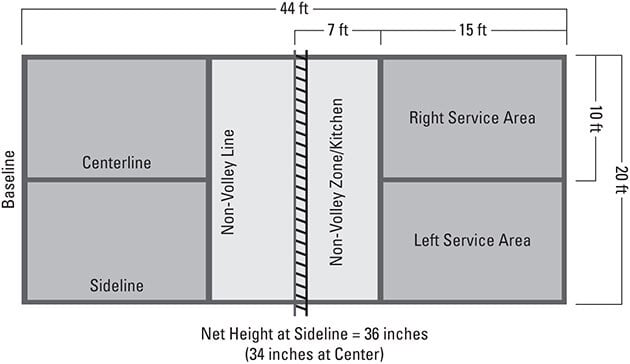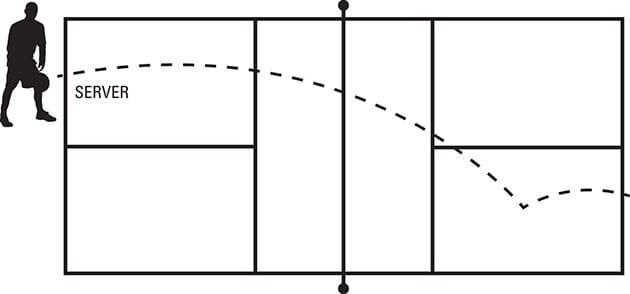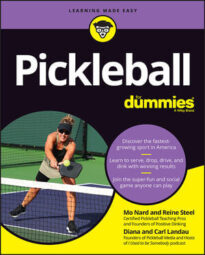What are the pickleball rules?
An official pickleball rule book currently runs about 75 pages, but you don’t need to commit all that to memory. The rules summary in this article will help you get out on the court and play your first few games today.Pickleball is a very social sport, so even if you don’t know all the rules yet, there’s probably another player on the court (or three) who are willing to help you. They were all beginners once, too, so don’t be shy!
This article focuses on playing doubles, which is, by far, the most popular format.
Layout of the pickleball court
The pickleball court is laid out the same for both singles and doubles. It’s a rectangle that measures 44 feet long by 20 feet wide. This is the same size as a doubles badminton court, or roughly one third the size of a tennis court.Along the outside boundaries of the court, you’ll find the sidelines on the long ends and the baselines on the shorter ends.
 ©John Wiley & Sons, Inc.
©John Wiley & Sons, Inc.The court is divided in the middle by a net, or as we like to call her, “Annette.” A real heartbreaker, Annette’s measurements are 36-34-36 — she’s 36 inches tall at the sidelines and 34 inches at the center.
Although a pickleball net is actually 2 inches lower than a tennis net, the height relative to the size of the court can make Annette a lot like a bad ex — hard to get over!
On each half of the court is a 7-x-20-foot area directly in front of the net called the non-volley zone (NVZ), more commonly known as the kitchen. As the name non-volley zone implies, players aren’t allowed to hit a volley (a shot hit before the ball has bounced) while in this zone.
Historians aren’t sure how the kitchen got its nickname, but one theory claims that the term was borrowed from shuffleboard.
The court between the kitchen and the baseline is divided lengthwise into two service boxes by the centerline. (Historians haven’t spent any time researching that one.) The line that divides the kitchen from the service boxes is known as the non-volley zone line, or the kitchen line.
How to serve in pickleball
You can’t start playing a game of pickleball until somebody serves the ball. Here are the basic rules you need to know to get started serving:- You must serve diagonally (crosscourt) into the service box. Your serve must clear the kitchen (the non-volley zone) and bounce in the service box that’s diagonal from you, on the opponent’s side of the court. If it lands on the sideline, baseline, or centerline, the serve is considered in. If it lands on the kitchen line, it’s a fault. The illustration below shows the path of a serve into the correct service box.
 ©John Wiley & Sons, Inc.
©John Wiley & Sons, Inc.The path of a legal serve into the correct service box
- The ball must go over the net. If your serve goes into the net without going over, it’s a fault. If your serve glances off the top of the net but still lands in the service box, it’s good and must be played. If it touches the top of the net and lands out of bounds or in the kitchen, it’s a fault.
- You must strike the ball below the level of your waist with a low-to-high motion. You must serve underhand in pickleball, contacting the ball below your waist with an upward swing path. In addition, no part of your paddle may be higher than your wrist.
- If serving off the bounce, you may not add force to the bounce. You can choose to hit the ball out of the air, before it bounces, by either tossing or dropping the ball with your non-paddle hand. Or you may choose to hit it off a bounce, but in this case, you cannot apply any upward or downward force to the ball. This is called the drop serve.
- You must stand behind the baseline and between the imaginary extensions of the centerline and the sideline. At the moment you strike the ball, neither foot can be inside the court boundaries, and at least one foot must be touching the ground behind the baseline (both feet can’t be in the air). You can’t stand way off to the side when you serve; you must be standing in the area behind the service box on your side of the court.
- You get only one service attempt. You get just one chance to hit your serve in. If your serve goes into the net or out of bounds, you lose your serve and do not get to try again.
The two-bounce rule
After a player serves the ball, the receiver must let the serve bounce before they are allowed to hit it. (Otherwise, the world would be left wondering whether that serve was going to land in bounds.)When the receiver returns the ball to the serving team, that team must also let it bounce before they can hit. After those first two shots have been allowed to bounce, any player can legally volley, which means to hit the ball out of the air before it bounces.
The two-bounce rule is one of the genius ideas that makes pickleball great. It prevents the “serve-and-volley” strategy commonly used in tennis, keeping players from blasting a huge serve and immediately running up to the net to volley the next ball. For this reason, in pickleball, the serving team is not considered to be at an advantage at the start of each rally.
If you have trouble at first remembering to observe the two-bounce rule, just count the bounces in your head: “One … two … game on!” Another way to think about this rule is that the ball must bounce on each side of the court before players may volley. So, after you’ve watched the ball bounce on your side of the court, either on the serve or return, you can forget worrying about counting those darn bounces.
Starting positions
The server is the only player required to stand in any particular place on the court when the point begins. (Actually, there is a rule stating that you must stand on your own team’s side of the net, but we can’t imagine why you wouldn’t choose to do so).However, the two-bounce rule clearly influences where the other three players should stand at the start of the point.
Here’s the breakdown for each player:
- The server must stand behind the baseline. The rules state that the server must serve from behind the baseline and between the imaginary extensions of the centerline and sidelines.
- The server’s partner should also stay behind or near the baseline. Again, the two-bounce rule requires the serving team to let the return bounce before they can hit it. In case the return is hit deep, both members of the serving team will want to stay back as far as possible so that they won’t have to backpedal to hit the ball.
- The receiver stands behind the baseline. The two-bounce rule requires the receiver to let the serve bounce before they can return the serve. The receiver should also stay well behind the baseline in order to more easily deal with a deep serve.
- The receiver’s partner stands up at the kitchen line. Because the two-bounce rule affects only the serving team and the receiver, the receiver’s partner doesn’t worry about the two-bounce rule and instead focuses on being in the most offensive position at the kitchen line, ready to volley the next ball that comes to them.
If you’re not sure where you’re supposed to be standing, remember that all players should ideally stand behind the baseline at the beginning of the point, except for the person standing directly across from the server. Also, remember that when it’s your partner’s turn to serve, they need you back there with them. It’s their big moment! Stay back and support your partner when they’re serving. Only the receiver’s partner should be up at the kitchen line.

